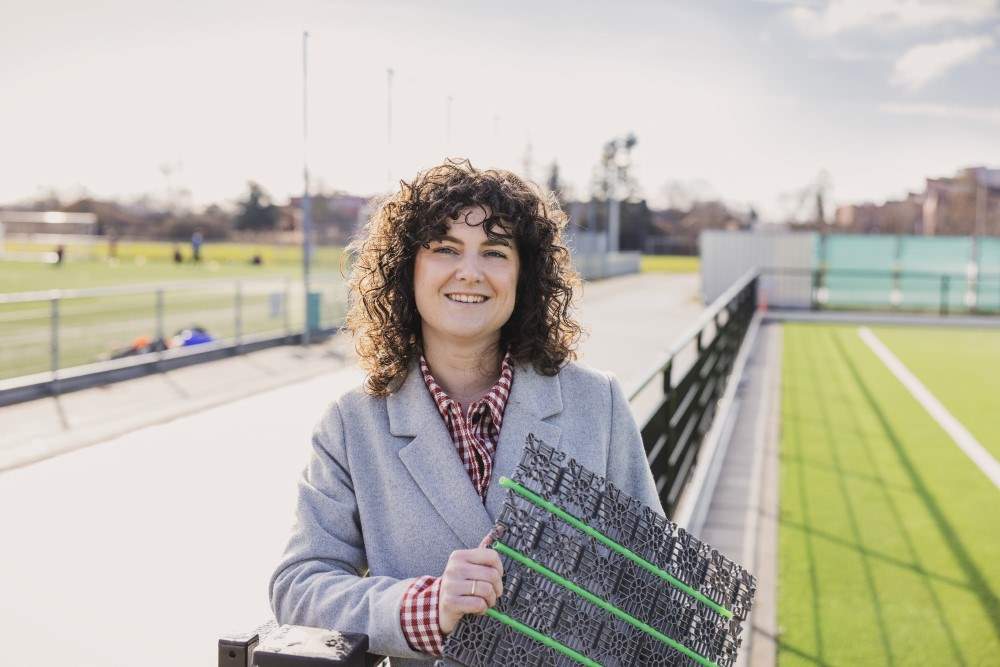‘Using artificial sports fields to generate renewable energy is so logical!’
Sallandse Wegenbouw was founded in 1991 by Johan Middelkamp. The company, with around sixty permanent employees, is based in Haarle. The organisation has three divisions: Sallandse Wegenbouw, Sallandse Milieu en Advies, and Sallandse United. The last of the three is active in the field of building sports facilities – from athletics tracks, tennis courts and netball courts through to artificial grass football and hockey pitches. In collaboration with SuperSub and Unica, Sallandse United converted half an artificial grass football pitch into a collector pitch in 2022.
Artificial grass as a source of heat
The functioning of a collector pitch is essentially very simple. “In the summer, artificial grass pitches can become extremely warm, up to more than 70 degrees Celsius. That makes them fabulous sources of heat,” explains Kim Middelkamp, director New Business at Sallandse Wegenbouw. “SuperSub has developed special slabs that can be laid underneath the artificial grass mat. The slabs contain a series of tubes through which a liquid flows. This liquid is heated by the sun that shines on the pitch, and in that way generates renewable energy. It seems so logical that it is difficult to understand why a system of this kind has never been thought of before.”
New energy
The collaboration between Sallandse United, SuperSub and Unica came about in the way that - as Kim puts it - things usually happen: by word of mouth. “We had been working on the idea of a collector pitch for about six months when a tender was placed on the market in 2020. The Province of Overijssel is keen to encourage new products in the field of renewable and new energy, and asked the question: ‘Is it possible to use sports grounds to generate energy?’ Thanks to our contacts with Eric Sarelse, the ‘techguy’ behind the SuperSub heat capture system, we knew: yes, they can! However, equally challenging and interesting was the question how you can use the heat generated in this way. My colleague Herald Kottink is an acquaintance of developer Marcel Gehrels at Unica Energy Solutions. Marcel was keen to contribute his thoughts and turned out to have valuable knowledge about how you could successfully use the harvested heat.”
Complementary knowledge
Kim explained that this was the start of a tripartite group who were able to complement each other and decided to sign up to the tender procedure together. “We at Sallandse Wegenbouw already have considerable experience in building sports facilities,” says Kim. “We also have a large regional network of local authorities and civil society organisations. SuperSub know all about heat capture and Unica are specialists in how to use the generated energy. For example to heat a swimming pool or sports campus, or as a source of heat for a heat network or CHP installation. After the province had selected our idea of the collector pitch, it was time for us to write a business case and build a pilot project.”
The first to try out the system was football club Be Quick ‘28 in Zwolle. “We converted half a football pitch into a collector pitch. The aim of the pilot was to measure the heat output and to acquire experience in laying and using a collector pitch.” As Kim explained, the laying of the pitch was not without obstacles. “The death of Eric Sarelse, the originator and driving force behind the project, was a major setback. And the war in Ukraine meant that the materials were not delivered on time, which in turn meant we could not start until October. We would have preferred to test in the summer, for the best possible results, but fortunately October was a warm month, too.”

‘The collector pitch is a valuable piece of the puzzle in the energy transition’
Kim Middelkamp, director New Business at Sallandse Wegenbouw
Innovative idea
The result of the practical test – even in the autumn months – was better than expected. Partly thanks to an innovative idea from Unica. “Injecting cooled water into the pipes to encourage the use of the collector pitch together with a heat pump was a brilliant move,” explains Kim. “After all, the greater the temperature difference, the greater the yield.”
The initial data show that the energy yield from a single collector pitch is equivalent to the heating needs of around 160 households. “The measurement data are currently being checked by TNO, to provide an accurate year-round prediction. An attractive yield is important in encouraging local authorities and other parties to take the risk of investing in a collector pitch,” continues Kim. “But there are other benefits, too. A cooled pitch helps tackle heat stress and results in a better playing experience. Far more importantly, a sports facility that generates renewable energy adds value to the environment. Where wind farms and solar parks sometimes face resistance, no one is bothered by a sports ground. That makes the collector pitch a valuable piece of the puzzle in the energy transition.”
On the pitch
The project has in fact delivered an energy boost to Kim, too. “It takes a great deal of work getting all the traffic lights to switch to green, but it is well worth it. And it is a joint project. Just like at our company, Unica is a place for people who are ready to go that extra mile! Rather than standing and shouting from the side lines, they are keen to take up their place on the field of energy transition. Step by step, together we are proving that things can be done differently.”